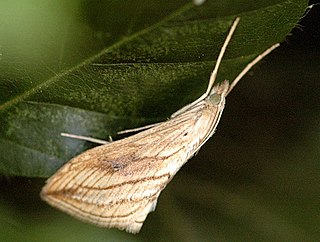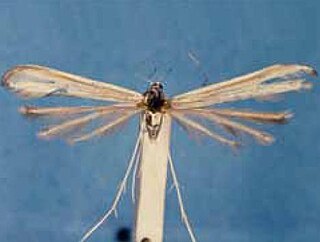
Evergestis forficalis, the garden pebble, is a species of moth of the family Crambidae. It is found in Europe, the Palearctic and North America. The species was described by Carl Linnaeus in his 1758 10th edition of Systema Naturae

Deilephila porcellus, the small elephant hawk-moth, is a moth of the family Sphingidae. The species was first described by Carl Linnaeus in his 1758 10th edition of Systema Naturae. It is found in Europe, North Africa and western Asia.

The Latin(Callopistria juventina) is a moth of the family Noctuidae. The species is found across the Palearctic realm.

Gillmeria pallidactyla is a moth of the family Pterophoridae first first described by the English entomologist, Adrian Hardy Haworth in 1811. It has a Holarctic distribution and is widespread throughout North America and the Palearctic.
Trichoptilus pygmaeus is a moth of the family Pterophoridae. It is found in North America, including California, Florida and British Columbia.

Oidaematophorus eupatorii, the eupatorium plume moth or Joe Pye plume moth, is a moth of the family Pterophoridae. It is found in North America, including Florida, Mississippi, Iowa, New York, California and Vancouver Island. It is also known from Mexico, Guatemala and Panama.
Hellinsia elliottii is a moth of the family Pterophoridae. It is found in North America, including Mississippi, New York, Iowa, Quebec, Alberta and Ontario.
Paraplatyptilia shastae is a moth of the family Pterophoridae. It is found in North America.
Paraplatyptilia albiciliatus is a moth of the family Pterophoridae. It is found in North America.
Paraplatyptilia albidorsellus is a moth of the family Pterophoridae. It is found in North America.
Adaina cinerascens is a moth of the family Pterophoridae. It is found in North America

Hellinsia homodactylus is a moth of the family Pterophoridae. It is found in North America and Guerrero in Mexico.
Hellinsia subochraceus is a moth of the family Pterophoridae. It is found in North America.
Hellinsia inconditus is a moth of the family Pterophoridae. It is found in North America.

Hellinsia agraphodactylus is a moth of the family Pterophoridae. It is found in the Dominican Republic. Records from North America are probably a misidentification.
Oidaematophorus cretidactylus is a moth of the family Pterophoridae that is found in North America.

Oidaematophorus guttatus is a moth of the family Pterophoridae. It is found in the United States.

Oidaematophorus grisescens is a moth of the family Pterophoridae. It is found in North America and Mexico.
Hellinsia australis is a moth of the family Pterophoridae that is found in the U.S. states of California and Utah.

Hellinsia tinctus is a moth of the family Pterophoridae. It is found in Arizona and Mexico.








